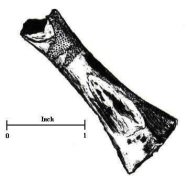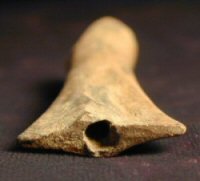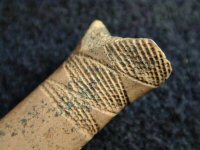Maryland Archaeological Conservation Laboratory
Main_Content
Curator's Choice 2008
Triangular Bit Smoking Pipe
May 2008
By Edward Chaney, MAC Lab Deputy Director
 In 1999, Jefferson Patterson Park & Museum archaeologists conducted a Phase I shovel test pit survey around a small tidal inlet known as Goose Creek, located aboard the Naval Air Station Patuxent River
in St. Mary's County. A number of prehistoric and historic sites were discovered during this survey. One of the sites, 18ST727, appears to have been a seasonally-occupied Late Woodland period camp. Artifacts
found at the site were typical of the period, and included 13 Townsend Series pottery sherds and a triangular Potomac projectile point (Sperling 2000). However, there was one unusual find there: a triangular
bit tobacco pipe fragment.
In 1999, Jefferson Patterson Park & Museum archaeologists conducted a Phase I shovel test pit survey around a small tidal inlet known as Goose Creek, located aboard the Naval Air Station Patuxent River
in St. Mary's County. A number of prehistoric and historic sites were discovered during this survey. One of the sites, 18ST727, appears to have been a seasonally-occupied Late Woodland period camp. Artifacts
found at the site were typical of the period, and included 13 Townsend Series pottery sherds and a triangular Potomac projectile point (Sperling 2000). However, there was one unusual find there: a triangular
bit tobacco pipe fragment.
 The pipe is 5.69 cm (2.24 in.) long, although much of the bowl is missing. The bit (mouth end) is 2.3 cm (0.9 in.) wide and 0.66 cm (0.26 in.) high at its thickest point, and has a round bore that is approximately
0.4 cm (0.16 in.) in diameter. This bore hole was probably made with a small stick or reed. The bit was carefully crafted and flared, and appears as an elongated diamond in cross section. Although the
bowl is largely missing,
The pipe is 5.69 cm (2.24 in.) long, although much of the bowl is missing. The bit (mouth end) is 2.3 cm (0.9 in.) wide and 0.66 cm (0.26 in.) high at its thickest point, and has a round bore that is approximately
0.4 cm (0.16 in.) in diameter. This bore hole was probably made with a small stick or reed. The bit was carefully crafted and flared, and appears as an elongated diamond in cross section. Although the
bowl is largely missing,  similar pipes generally have bowls that extend at an obtuse angle to
the stem. Sometimes the angle is very slight, which may have been the case with the Goose Creek pipe.
similar pipes generally have bowls that extend at an obtuse angle to
the stem. Sometimes the angle is very slight, which may have been the case with the Goose Creek pipe.
The pipe is made of untempered red clay, is burnished, and is decorated with a series of dentate-impressed geometric designs at the bowl end. These designs, consisting of at least two-and-a-half diamonds,
occur on both the top and bottom surfaces of the pipestem. The diamond patterns are carefully positioned along the centerlines of the pipe, and wrap around the stem, where they meet the ends of the diamond
decorations from the opposite side. This type of decoration was in use by at least the thirteenth century AD in Virginia (Potter 1993:226).
 Triangular bit pipes are seldom found in lower Southern Maryland, and seem to be generally rare throughout the Middle Atlantic region. However, specimens have been found at sites like Potomac Creek (44ST2) in
Virginia and Accokeek Creek (18PR8) in Maryland (Schmitt 1965; Stephenson and Ferguson 1963; Stewart 1992), as well as elsewhere. All known examples of triangular bit pipes have been recovered from Late Woodland
components. The care with which they were crafted makes them some of the finest examples of the Indian pipemaker’s art in the Chesapeake region.
Triangular bit pipes are seldom found in lower Southern Maryland, and seem to be generally rare throughout the Middle Atlantic region. However, specimens have been found at sites like Potomac Creek (44ST2) in
Virginia and Accokeek Creek (18PR8) in Maryland (Schmitt 1965; Stephenson and Ferguson 1963; Stewart 1992), as well as elsewhere. All known examples of triangular bit pipes have been recovered from Late Woodland
components. The care with which they were crafted makes them some of the finest examples of the Indian pipemaker’s art in the Chesapeake region.
Pipe from 44St2, similar to the Goose Creek example.
Reproduced from Stewart 1992.
| References |
|
| Potter, Stephen R. |
| 1993 |
Commoners, Tribute, and Chiefs: The Development of Algonquian Culture in the Potomac Valley. University Press of Virginia, Charlottesville. |
|
| Schmitt, Karl Jr. |
| 1965 |
Patawomeke: An Historic Algonkian Site. Archaeological Society of Virginia Quarterly Bulletin 20(1):1-36. |
|
| Sperling, Christopher |
| 2000 |
A Phase I Archaeological Survey of Goose Creek Aboard Naval Air Station Patuxent River. Prepared by the Maryland Archaeological Conservation Laboratory. Submitted to the Natural and Cultural Resources Branch, Department of Public Works, Naval Air Station Patuxent River. Jefferson Patterson Park & Museum Occasional Papers #11. St. Leonard, Maryland. |
|
| Stephenson, Robert L. and Alice L. L. Ferguson |
| 1963 |
The Accokeek Creek Site: A Middle Atlantic Seaboard Culture Sequence. Anthropological Papers Museum of Anthropology, University of Michigan #20. Ann Arbor, Michigan. |
|
| Stewart, T. Dale |
| 1992 |
Archaeological Exploration of Patawomeke: The Indian Town Site (44ST2) Ancestral to the one (44ST1) visited in 1608 by Captain John Smith. Smithsonian Contributions to Anthropology #36. Smithsonian Institution Press, Washington, D.C. |
|